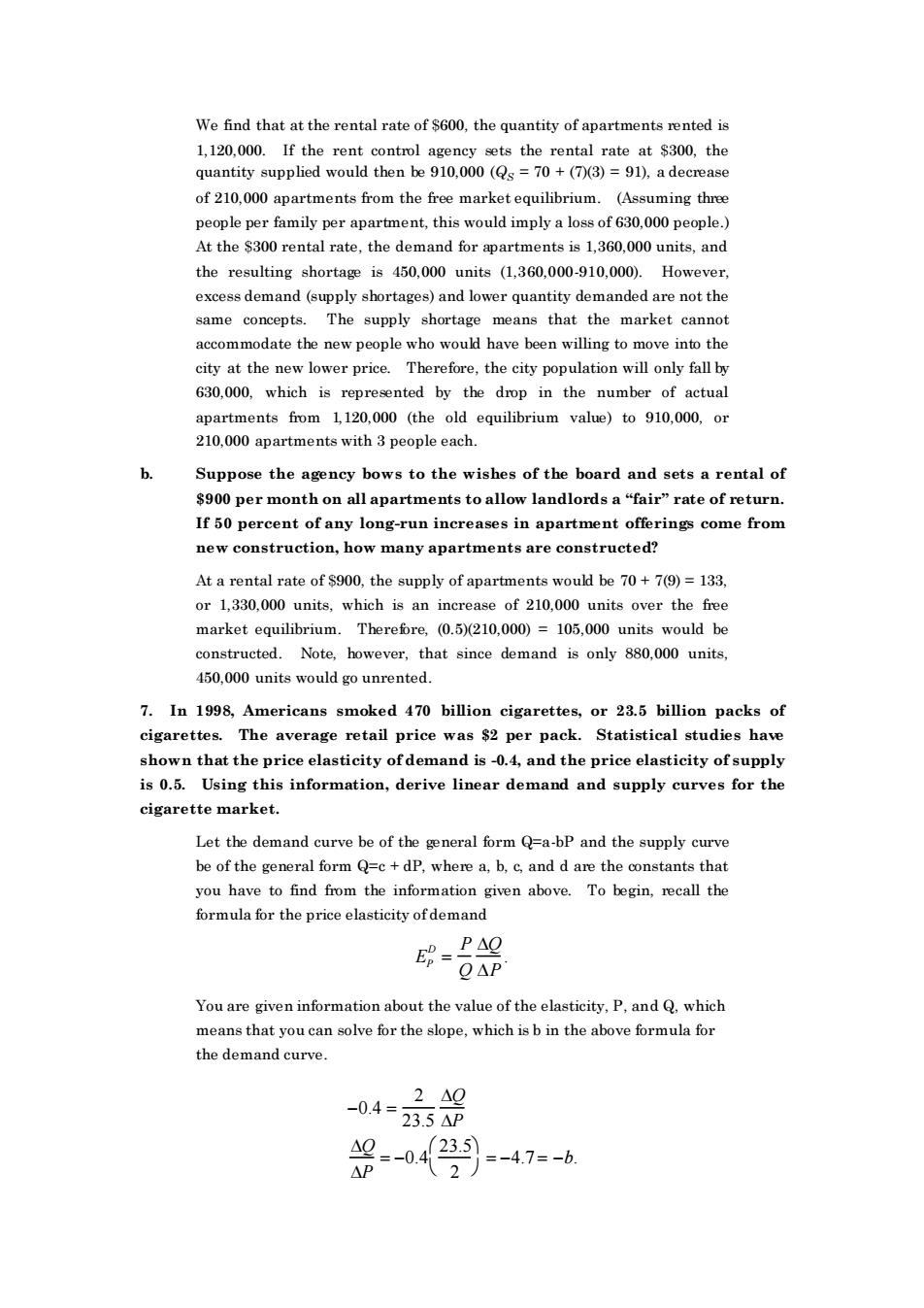正在加载图片...

We find that at the rental rate of S600.the guantity of apartments rented is 1,120,000.fthe ntal of 210,000 apartments from the free market equilibrium.(Assuming three people per family per apartment,this would imply a loss of 630.000 people.) At the S300 rental rate,the demand for apartments is 1.360.000 units.and the resulting shortage is50.000 units (1,60.000-910.000).Howeve excess demand (supply shortages)and lower quantity demanded are not the same concepts. The supply shortage means that the market cannot accommodate the new people who would have been willing to move into the city at the new lower price.Therefore.the city population will only fall by 630,000,which is rep esented by the drop in the number of actual apartments from 1120.000 (the old equilibrium value)to 910.000 210.000 apartments with 3 people each Suppose the agency bows to the wishes of the board and sets a rental of $900 per month on all apartments to allow landlords a "fair"rate of return. If 50 percent of any long-run increases in apartment offerings come from new construction,how many apartments are constructed? At a rental rate of $900,the supply of apartm nts would be 70+7(9)=133 0r1,330,000 anits,which is an creas f210.000 nit over the fre market equilibrium Therefre,(0.5)(210,000)=105,000 units would be constructed.Note,however,that since demand is only 880,000 units, 450,000 units would go unrented. 7.In 1998,Americans smoked 470 billion cigarettes,or 23.5 billion packs of cigarettes.The average retail price was s2 per pack.Statistical studies have shown that the price elasticity of demand and the price elasticity ofsuppl is 0.5.Using this information,derive linear demand and supply curves for the cigarette market. Let the demand curve be of the general form Q=a-bP and the supply curve be of the general form Q=c+dP.where a,b,c and d are the constants that you have to find from the information given above.To begin.recall the formula for the price elasticity of demand ED= P△C 0△P You are given information about the value of the elasticity,P,and Qwhich means that you can solve for the slope,which is b in the above formula for the demand curve. 2△≌ -04=235P 2=-4.7=-bWe find that at the rental rate of $600, the quantity of apartments rented is 1,120,000. If the rent control agency sets the rental rate at $300, the quantity supplied would then be 910,000 (QS = 70 + (7)(3) = 91), a decrease of 210,000 apartments from the free market equilibrium. (Assuming three people per family per apartment, this would imply a loss of 630,000 people.) At the $300 rental rate, the demand for apartments is 1,360,000 units, and the resulting shortage is 450,000 units (1,360,000-910,000). However, excess demand (supply shortages) and lower quantity demanded are not the same concepts. The supply shortage means that the market cannot accommodate the new people who would have been willing to move into the city at the new lower price. Therefore, the city population will only fall by 630,000, which is represented by the drop in the number of actual apartments from 1,120,000 (the old equilibrium value) to 910,000, or 210,000 apartments with 3 people each. b. Suppose the agency bows to the wishes of the board and sets a rental of $900 per month on all apartments to allow landlords a “fair” rate of return. If 50 percent of any long-run increases in apartment offerings come from new construction, how many apartments are constructed? At a rental rate of $900, the supply of apartments would be 70 + 7(9) = 133, or 1,330,000 units, which is an increase of 210,000 units over the free market equilibrium. Therefore, (0.5)(210,000) = 105,000 units would be constructed. Note, however, that since demand is only 880,000 units, 450,000 units would go unrented. 7. In 1998, Americans smoked 470 billion cigarettes, or 23.5 billion packs of cigarettes. The average retail price was $2 per pack. Statistical studies have shown that the price elasticity of demand is -0.4, and the price elasticity of supply is 0.5. Using this information, derive linear demand and supply curves for the cigarette market. Let the demand curve be of the general form Q=a-bP and the supply curve be of the general form Q=c + dP, where a, b, c, and d are the constants that you have to find from the information given above. To begin, recall the formula for the price elasticity of demand EP D = P Q Q P . You are given information about the value of the elasticity, P, and Q, which means that you can solve for the slope, which is b in the above formula for the demand curve. −0.4 = 2 23.5 Q P Q P = −0.4 23.5 2 = −4.7 = −b